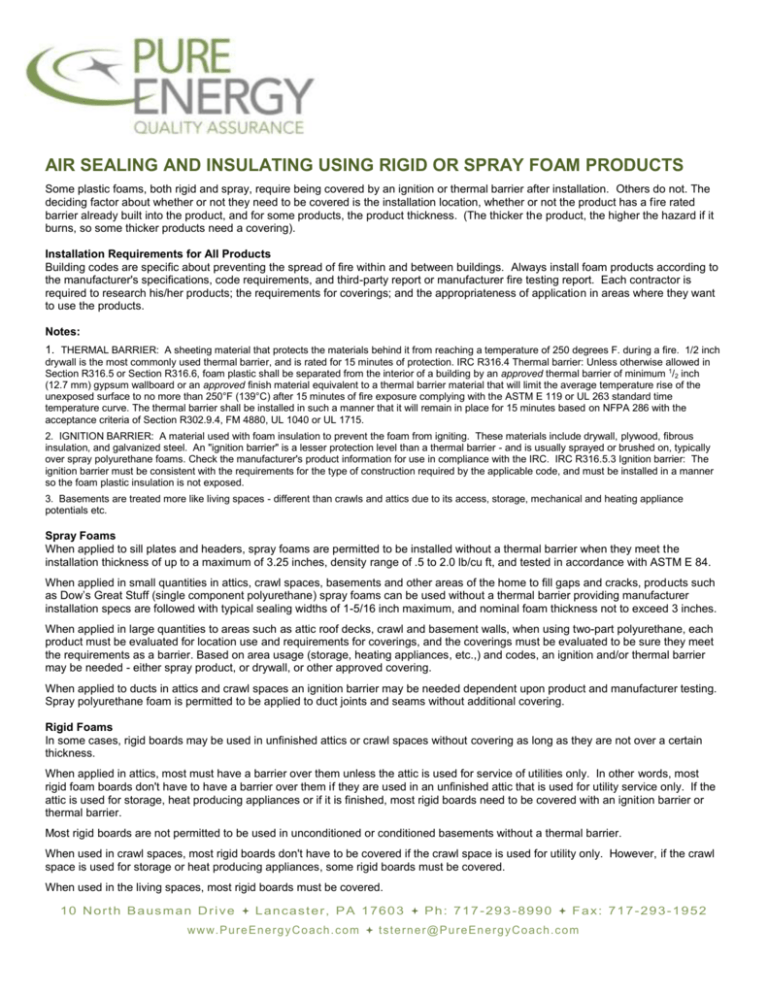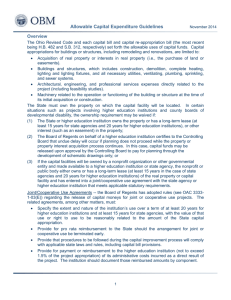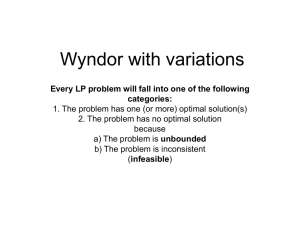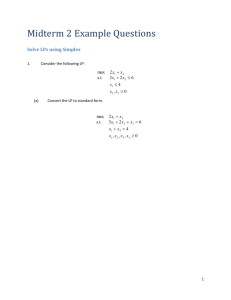Air Sealing and Insulating Using Rigid or Spray Foam Products
advertisement

AIR SEALING AND INSULATING USING RIGID OR SPRAY FOAM PRODUCTS Some plastic foams, both rigid and spray, require being covered by an ignition or thermal barrier after installation. Others do not. The deciding factor about whether or not they need to be covered is the installation location, whether or not the product has a fire rated barrier already built into the product, and for some products, the product thickness. (The thicker the product, the higher the hazard if it burns, so some thicker products need a covering). Installation Requirements for All Products Building codes are specific about preventing the spread of fire within and between buildings. Always install foam products according to the manufacturer's specifications, code requirements, and third-party report or manufacturer fire testing report. Each contractor is required to research his/her products; the requirements for coverings; and the appropriateness of application in areas where they want to use the products. Notes: 1. THERMAL BARRIER: A sheeting material that protects the materials behind it from reaching a temperature of 250 degrees F. during a fire. 1/2 inch drywall is the most commonly used thermal barrier, and is rated for 15 minutes of protection. IRC R316.4 Thermal barrier: Unless otherwise allowed in Section R316.5 or Section R316.6, foam plastic shall be separated from the interior of a building by an approved thermal barrier of minimum 1/2 inch (12.7 mm) gypsum wallboard or an approved finish material equivalent to a thermal barrier material that will limit the average temperature rise of the unexposed surface to no more than 250°F (139°C) after 15 minutes of fire exposure complying with the ASTM E 119 or UL 263 standard time temperature curve. The thermal barrier shall be installed in such a manner that it will remain in place for 15 minutes based on NFPA 286 with the acceptance criteria of Section R302.9.4, FM 4880, UL 1040 or UL 1715. 2. IGNITION BARRIER: A material used with foam insulation to prevent the foam from igniting. These materials include drywall, plywood, fibrous insulation, and galvanized steel. An "ignition barrier" is a lesser protection level than a thermal barrier - and is usually sprayed or brushed on, typically over spray polyurethane foams. Check the manufacturer's product information for use in compliance with the IRC. IRC R316.5.3 Ignition barrier: The ignition barrier must be consistent with the requirements for the type of construction required by the applicable code, and must be installed in a manner so the foam plastic insulation is not exposed. 3. Basements are treated more like living spaces - different than crawls and attics due to its access, storage, mechanical and heating appliance potentials etc. Spray Foams When applied to sill plates and headers, spray foams are permitted to be installed without a thermal barrier when they meet the installation thickness of up to a maximum of 3.25 inches, density range of .5 to 2.0 lb/cu ft, and tested in accordance with ASTM E 84. When applied in small quantities in attics, crawl spaces, basements and other areas of the home to fill gaps and cracks, products such as Dow’s Great Stuff (single component polyurethane) spray foams can be used without a thermal barrier providing manufacturer installation specs are followed with typical sealing widths of 1-5/16 inch maximum, and nominal foam thickness not to exceed 3 inches. When applied in large quantities to areas such as attic roof decks, crawl and basement walls, when using two-part polyurethane, each product must be evaluated for location use and requirements for coverings, and the coverings must be evaluated to be sure they meet the requirements as a barrier. Based on area usage (storage, heating appliances, etc.,) and codes, an ignition and/or thermal barrier may be needed - either spray product, or drywall, or other approved covering. When applied to ducts in attics and crawl spaces an ignition barrier may be needed dependent upon product and manufacturer testing. Spray polyurethane foam is permitted to be applied to duct joints and seams without additional covering. Rigid Foams In some cases, rigid boards may be used in unfinished attics or crawl spaces without covering as long as they are not over a certain thickness. When applied in attics, most must have a barrier over them unless the attic is used for service of utilities only. In other words, most rigid foam boards don't have to have a barrier over them if they are used in an unfinished attic that is used for utility service only. If the attic is used for storage, heat producing appliances or if it is finished, most rigid boards need to be covered with an ignition barrier or thermal barrier. Most rigid boards are not permitted to be used in unconditioned or conditioned basements without a thermal barrier. When used in crawl spaces, most rigid boards don't have to be covered if the crawl space is used for utility only. However, if the crawl space is used for storage or heat producing appliances, some rigid boards must be covered. When used in the living spaces, most rigid boards must be covered. 10 North Bausman Drive Lancaster, PA 17603 Ph: 717-293-8990 Fax: 717-293-1952 www.PureEnergyCoach.com tsterner@PureEnergyCoach.com 2 Rigid Board Foam - Example Table of What is Allowed without a protective covering, based on IRC 2009 Section R316.6. Contractors are responsible for consulting product manufacturer and the third-party evaluations and updates to ensure they are following the most recent specific material and installation requirements. Product Examples as of April 2011 Application / Location Thermax Attic (unfinished) (service of utilities only) Allowable Polyisocyanurate Tuff-R And Super Tuff-R Allowable, but if thicker than 1", it must be covered XPS GreenGuard Board Foil Bubble Type Reflectix XPS/EPS Styrofoam Brand Beadboard Allowable, but if thicker than ¾”, it must be covered Allowable when used with With Reflectix tape Depending on type, thickness and coating Not allowable if the attic contains heat producing appliances No storage permitted Attic (unfinished with storage) Allowable Not Allowable Not Allowable Allowable when used with With Reflectix tape Depending on type, thickness and coating Attic (finished) Allowable Not Allowable Not Allowable Not Allowable Not Allowable *Basement (conditioned or unconditioned) Allowable Not Allowable Not Allowable Not Allowable Not Allowable Crawl Space (service of utilities only) Allowable Allowable, but if thicker than 1", it must be covered Allowable, but if thicker than ¾”, it must be covered Allowable when used with With Reflectix tape Depending on type, thickness and coating Not allowable if the crawl space contains heat producing appliances No storage permitted Crawl Space (with storage) Allowable Not Allowable Not Allowable Allowable when used with With Reflectix tape Depending on type, thickness and coating Living Area Allowable Not Allowable Not Allowable Not Allowable Not Allowable Ducts (unconditioned areas) Not Appropriate Not Appropriate Not Appropriate Allowable Except in high traffic areas Not Allowable or appropriate * Note: Basements are considered differently than attics, crawlspaces, and living areas, but mostly are considered living area due to access to stored items, mechanicals, and heat producing appliance potential. 10 North Bausman Drive Lancaster, PA 17603 Ph: 717-293-8990 Fax: 717-293-1952 www.PureEnergyCoach.com tsterner@PureEnergyCoach.com 3 Spray Foam - Example Table of What is Allowed without a protective covering, based on IRC 2009 Section R316.6. Contractors are responsible for consulting product manufacturer and the third-party evaluations and updates to ensure they are following the most recent specific material and installation requirements. Product Examples as of April 2011 One-part spray foam for small gaps and cracks Great Stuff By Dow Two-part spray for larger applications polyurethane By Demilec Attic (unfinished) (service of utilities only) Allowable, but it must be covered if thicker than 3" and/or wider than 1 5/16" Allowable Attic (unfinished with storage) Allowable, but it must be covered if thicker than 3" and/or wider than 1 5/16" Not Allowable without ignition barrier Attic (finished) Allowable, but it must be covered if thicker than 3" and/or wider than 1 5/16" Not allowable Application / Location No storage permitted and access size may be limited per codes Codes permitting *Basement (conditioned or unconditioned) Allowable, but it must be covered if thicker than 3" and/or wider than 1 5/16" Allowable in rim joists, sill plates, and headers only Crawl Space (service of utilities only) Allowable, but it must be covered if thicker than 3" and/or wider than 1 5/16" Allowable Crawl Space (with storage) Allowable, but it must be covered if thicker than 3" and/or wider than 1 5/16" Not Allowable Living Area Allowable, but it must be covered if thicker than 3" and/or wider than 1 5/16" Not Allowable No storage permitted and access size may be limited per codes Same as above Codes permitting Ducts (unconditioned areas) Allowed for joints and seams but Not Appropriate Allowed for joints and seams * Note: Basements are considered differently than attics, crawlspaces, and living areas, but mostly are considered living area due to access to stored items, mechanicals, and heat producing appliance potential. 10 North Bausman Drive Lancaster, PA 17603 Ph: 717-293-8990 Fax: 717-293-1952 www.PureEnergyCoach.com tsterner@PureEnergyCoach.com






